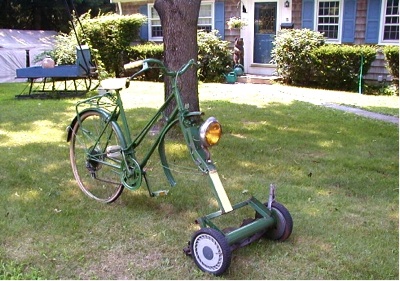Friday, October 19, 2007
Wednesday, October 17, 2007
How To Calculate The Distance To The Horizon
How to Calculate the Distance to the Horizon
Have you ever watched the sun disappear into the horizon and wondered, "How far is the horizon from where I'm standing?" If you can measure how high your eyes are from sea level, you can actually calculate the distance between you and the horizon as follows.
[edit] Steps
- Measure your "height of eye." Measure the length between the ground and your eyes in meters or feet. One way to calculate this is to measure the distance between your eyes and the top of your head. Subtract this value from your total height and what will be left is the distance between your eyes and the surface you're standing on. If you are standing exactly at sea level, with the bottom of your feet level with the water, this is the only measurement you'll need.
- Add your "local elevation" if you're standing on a raised surface, such as a hill, building or boat. How many meters or kilometers above sea level are you standing? 1 meter? 4,000 feet? Add that number to your height of eye (in the same units, of course).
- Multiply by 13 if you took the measurement in meters, or multiply by 1.5 if you took the measurement in feet.
- Take the square root to find the answer. If you used meters, your answer will be in kilometers, and if feet, miles. The distance calculated is a straight line from your eyes to the horizon. The actual distance you'll travel to get to the horizon will be longer because of surface curvature and (on land) irregularities. Proceed to the next method below for a more accurate (and complicated) formula.
- Understand how this calculation works. It's based on a triangle formed by your observation point (your eyes), the true horizon point (what you're looking at) and the center of the Earth. By knowing the radius of the Earth and measuring your height of eye and local elevation, that leaves only the distance between your eyes and the horizon as unknown. Since the sides of the triangle that meet at the horizon actually form a right angle, we can use the Pythagorean theorem (good old a^2 + b^2 = c^2) as the basis for this calculation, where:
• a = R (the radius of the Earth)
• b = the distance to the horizon, unknown
• c = h (your height of eye) + R
Alternate Method #1
- Calculate the actual distance you'd have to traverse to get to the horizon by using this formula:
d = R * arccos(R/(R + h))
d = distance to horizon
R = radius of the Earth
h = height of eye - Increase R by 20% to compensate for the distorting refraction of light rays and to arrive at a more accurate measurement.
- Figure out how this calculation works. This will calculate the length of the curved line that follows from your feet to the true horizon. Now, the arccos(R/(R+h)) portion refers to the angle that is made at the center of the Earth by the line going from the true horizon to the center and the line going from you to the center. With this angle, we multiply it by R to get the "arc length," which, in this case, is the distance that you are looking for.
Alternate Method #2
- Assume a flat plane or the ocean. This method is a simpler version of the first set of instructions presented in this article, and applies only in feet and miles.
- Solve for the distance in miles by plugging in the your height of eye in feet (h) into the following formula:
d = 1.2246* SQRT(h) - Derive the formula from the Pythagorean theorem.
(R + h)^2 = R^2 + d^2
Solving for h (making the assumption that R>>h and expressing the radius of the earth in miles, approx. 3959) yields the expression:
d = SQRT(2*R*h)
[edit] Tips
- These calculations are most commonly used if you are looking at the true horizon, or where the sky and the Earth would meet if there were not any barriers or obstructions in your way (which is usually the case at sea, unless there's a land mass in the way). On land, however, there may be mountains or buildings in front of the true horizon, in which case these calculations will still tell you how far you are from the true horizon, but you'll have to tack on any additional distance created by having to climb over or circumvent the obstacles that are in your way.
[edit] Sources and Citations
Monday, October 15, 2007
Ghost In The Graveyard
How to Play Ghost in the Graveyard
Traditionally, during the first warm spring night children play Ghost in the Graveyard- a game that may be known by many other names, such as "The Witch Ain't Out Tonight" and "Bloody Murder". It's not only fun, but it's also good exercise. This is an old game that has been handed down from one generation to another. Let's not lose it![edit] Steps
- Find some friends to play. The more people you can round up, the better.
- Choose one house in the neighborhood for the playing field. You will need a home base where everyone can stand or all touch at the same time such as a large tree, front stoop, or back patio.
- Choose one person to be the ghost. You can do this any way you like: picking a number, asking for a volunteer, rock, paper, scissors, etc.
- Have everyone but the ghost stand at the home base while the ghost runs off to hide somewhere around the outside of the house and hides.
- Chant slowly as a group: "One o'clock . . . two o'clock . . . three o'clock . . ." and so on, up to twelve o'clock. Then shout, "Midnight! I hope I don't see the ghost tonight!". Alternatively, "Starlight, star bright, I hope to see a ghost tonight!"
- Leave the home base in either direction and make your way around the yard. When anyone encounters the ghost they yell, "Ghost in the graveyard!" and try to run away. When the ghost catches someone, they become a ghost too. Anyone who is able to run back to home base is safe.
- Have all the people who were caught go and hide with the original ghost. The people on the home base start again with the chant: "One o'clock . . . two o'clock . . ."
- Continue the game like this until everyone is caught. The last person caught becomes the ghost for the next round.
[edit] Tips
- Be sure and wait until after dark to play.
- Home base should be able to hold all players.
- In some variations of the game, the ghost counts to twelve o'clock and then everyone else shouts, "Midnight!" but this has the disadvantage of potentially giving the ghost's hiding spot away.
- Another version has all those on home base actually go and seek out the ghost, who remains hiding. The person who finds the ghost yells out, and all must then flee from the ghost and return to base.
- The ghost may also be called, in some variations of the game, a "witch" or "bloody murderer."
- In another variation of the game, multiple ghosts can play. This works well with a lot of people playing.
- You can choose a different place to play, such as a grass field.
- Another variation of the game is where the ghost hides and each player hold hands, and when the ghost is spotted you must dash back to home.
Saturday, October 13, 2007
Great Idea
Great Minds Think Alike: the Bicycle Lawnmower!
Over at Treehugger, Warren McLaren has rounded up all the examples of this ingenious, indigenous, "labor-saving" invention that he could find.

It is apparent that thousands of people who have to mow the lawn decided there must be an easier way and had exactly the same idea: Why not hook the mower to a bike? And so the bikemower is born in a thousand of garages around the country. Judging from the pictures, they are still in the garages. Most of the pics rounded up by McLaren look as if they were taken at garage sales. I have my doubts that the bike mower is very useful, or easier to use than pushing on your feet.


For the full set see the Treehuger post above.
Posted on September 28, 2007 at 12:48 PM | +del.icio.us +digg +reddit
Friday, October 05, 2007
This Don't Need a Title
Sep 24, 2007 2:14 PM Fart Store in Poland |
Paintball Tank!
Sep 27, 2007 5:14 AM Paintball-Firing Mini Tank |
President Tyler's Grandson
Oct 2, 2007 (3 days ago) Presidential Grandson |
Hot water freezes faster than cold water?
Trivia: Hot Water Freezes Faster Than Cold Water
 Hot water freezes faster than cold water. It was (re)discovered by a Tanzanian high school student named Erasto Mpemba, so the phenomenon is called the Mpemba effect.
Hot water freezes faster than cold water. It was (re)discovered by a Tanzanian high school student named Erasto Mpemba, so the phenomenon is called the Mpemba effect.
Counter-intuitive, isn’t it? Read more about why hot water freezes faster than cold water here. [Update 9/28/07: technically, hot water freezes first (it actually forms ice at a higher temperature than cold water), but cold water freezes faster (it takes less time to reach the supercooled state, from which it forms ice) - to say the least, it’s complicated… ]




 This Funtrak Mini Paintball Tank is just like the real war machine, just scaled down a little … It even lets you fire paintballs through its cannon while you drive around terrorizing the neighborhood!
This Funtrak Mini Paintball Tank is just like the real war machine, just scaled down a little … It even lets you fire paintballs through its cannon while you drive around terrorizing the neighborhood!
